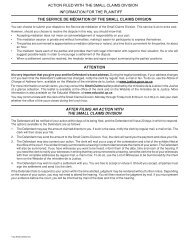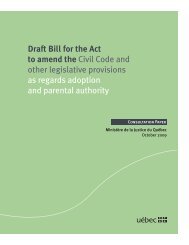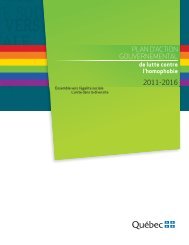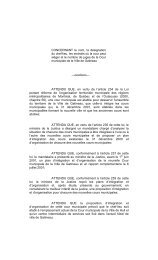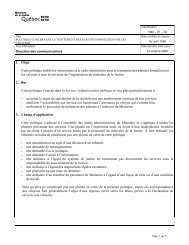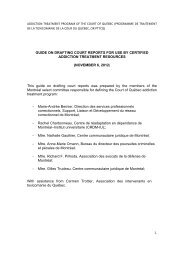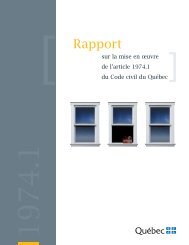- Page 1 and 2: La révision de la procédure civil
- Page 3: Dépôt légal - 3 e trimestre 2001
- Page 8 and 9: iv 2.1.5.3. La situation au Québec
- Page 10 and 11: vi 3.4.2.3. La défense 120 3.4.2.4
- Page 12 and 13: viii 5.4.5. La suspension du délai
- Page 14 and 15: x 7. L’exécution des jugements 2
- Page 16 and 17: INTRODUCTION 1. LA NÉCESSAIRE RÉV
- Page 18 and 19: 3 considérer la force exécutoire
- Page 20 and 21: 5 expliciteraient la conception gé
- Page 22 and 23: 7 Chacun de ces groupes était anim
- Page 24 and 25: 9 de la consultation publique, d’
- Page 26 and 27: 11 4° la mise en place de régimes
- Page 28 and 29: 13 À titre complémentaire, le tab
- Page 30 and 31: 15 dans 88 % des cas, une partie ag
- Page 32 and 33: 17 importantes dans les budgets de
- Page 34 and 35: 19 garanties constitutionnelles, do
- Page 36 and 37: 21 d’appel soulignaient qu’à l
- Page 38 and 39: 23 situation le justifie et rendre
- Page 40 and 41: 25 mesure de disposer d’instrumen
- Page 42 and 43: 27 II. UNE NOUVELLE VISION DE LA PR
- Page 44 and 45: 29 rapide et simple qui permet de c
- Page 46 and 47: 31 judiciaires dans les cours féd
- Page 48 and 49: 33 dans l’instance, les prétenti
- Page 50 and 51: 35 III. LES ORIENTATIONS PRIVILÉGI
- Page 52 and 53: 37 Dans le premier cas, ils peuvent
- Page 54 and 55: 39 délais en soient raisonnables.
- Page 56 and 57:
41 Par ailleurs, même si son premi
- Page 58 and 59:
43 Dans un autre ordre d’idées,
- Page 60 and 61:
45 Plusieurs dispositions du Code,
- Page 62 and 63:
47 R.1-24 De prévoir que la signat
- Page 64 and 65:
49 à-dire celle selon laquelle cer
- Page 66 and 67:
51 Ainsi, le Rapport recommandait d
- Page 68 and 69:
53 • le rejet administratif des p
- Page 70 and 71:
55 2.1.1.3. La position du Comité
- Page 72 and 73:
57 l’année 2000, le nombre de do
- Page 74 and 75:
59 Le Comité recommande donc : R.2
- Page 76 and 77:
61 2.1.2.1.2. La position du Comit
- Page 78 and 79:
63 • une ordonnance enjoignant à
- Page 80 and 81:
65 Le Comité recommande donc : R.2
- Page 82 and 83:
67 prévues dans quatre lois releva
- Page 84 and 85:
69 quatre nouvelles villes 169 et
- Page 86 and 87:
71 Le 27 mai 1997, le gouvernement
- Page 88 and 89:
73 Le Comité n’entend pas remett
- Page 90 and 91:
75 Il existe une disparité entre l
- Page 92 and 93:
77 100 000 $ par jour, sans remettr
- Page 94 and 95:
79 • procéder par mini-procès e
- Page 96 and 97:
81 • la conférence est tenue san
- Page 98 and 99:
83 2.3.3.4. Le caractère exécutoi
- Page 100 and 101:
85 Le Comité recommande donc : R.2
- Page 102 and 103:
87 concernant notamment les pension
- Page 104 and 105:
89 2.4.2.2.1.3. Aux États-Unis Dan
- Page 106 and 107:
91 croire à une relation personnel
- Page 108 and 109:
93 Le rôle d’aide et d’assista
- Page 110 and 111:
95 un ou plusieurs palais de justic
- Page 112 and 113:
97 2.4.3.1.1.2. La transmission par
- Page 114 and 115:
99 4° la certification, c’est-à
- Page 116 and 117:
101 2.4.3.2.3. En Ontario La Loi su
- Page 118 and 119:
103 2.4.3.3. Les propositions déj
- Page 120 and 121:
105 novembre 1998. À la suite de c
- Page 122 and 123:
107 R.2-55 De prévoir qu’un inte
- Page 124 and 125:
109 être inscrite pour enquête et
- Page 126 and 127:
111 Les caractéristiques principal
- Page 128 and 129:
113 3.3. L’INTRODUCTION DE L’IN
- Page 130 and 131:
115 3.4.1. Le déroulement de l’i
- Page 132 and 133:
117 L’échéancier Les articles 7
- Page 134 and 135:
119 Au sujet des moyens préliminai
- Page 136 and 137:
121 Tout en recommandant de mainten
- Page 138 and 139:
123 - les demandes faites à la suc
- Page 140 and 141:
125 R.3-19 De prévoir la procédur
- Page 142 and 143:
127 3.4.2.5.5. La récusation La co
- Page 144 and 145:
129 textuellement cette disposition
- Page 146 and 147:
131 Le Comité recommande donc : R.
- Page 148 and 149:
133 Il paraît opportun, compte ten
- Page 150 and 151:
135 • l’inventaire des pièces
- Page 152 and 153:
137 À défaut d’inscription à l
- Page 154 and 155:
139 Lorsque l’instance est introd
- Page 156 and 157:
141 avec la partie qu’il représe
- Page 158 and 159:
143 Le Premier rapport exprime l’
- Page 160 and 161:
145 • les procédures doivent êt
- Page 162 and 163:
147 4.2.2.3.3. Les objections antic
- Page 164 and 165:
149 4.3.2. Le témoignage écrit, l
- Page 166 and 167:
151 recommandation du Rapport Woolf
- Page 168 and 169:
153 Le Comité croit donc opportun
- Page 170 and 171:
155 • 30 jours pour les jugements
- Page 172 and 173:
157 l’exécution du mandat de l
- Page 174 and 175:
159 placé dans une situation où l
- Page 176 and 177:
161 R.5-13 De préciser qu’une de
- Page 178 and 179:
163 alors qu’en vertu de la secon
- Page 180 and 181:
165 R.5-18 R.5-19 R.5-20 De prévoi
- Page 182 and 183:
167 Le Code ne définit pas ce qu
- Page 184 and 185:
169 l’administration provisoire d
- Page 186 and 187:
171 à la sauvegarde des droits des
- Page 188 and 189:
173 6.2.2.1. La production des inte
- Page 190 and 191:
175 • que le juge rend une ordonn
- Page 192 and 193:
177 L’accréditation devrait faci
- Page 194 and 195:
179 Le Comité recommande donc : R.
- Page 196 and 197:
181 particulièrement lorsque l’u
- Page 198 and 199:
183 L’article 790 du Code prévoi
- Page 200 and 201:
185 parfois de façon substantielle
- Page 202 and 203:
187 En conclusion, sous réserve de
- Page 204 and 205:
189 6.5.2.2. Le débiteur Pour êtr
- Page 206 and 207:
191 débiteur précise les motifs d
- Page 208 and 209:
193 Il faudrait donc systématiser
- Page 210 and 211:
195 6.5.5. La preuve Actuellement e
- Page 212 and 213:
197 6.5.6.3. L’exécution À l’
- Page 214 and 215:
199 conditions, aux personnes moral
- Page 216 and 217:
201 communauté juridique et la pop
- Page 218 and 219:
203 Le Comité recommande donc : R.
- Page 220 and 221:
205 le juge qu’il nomme à cette
- Page 222 and 223:
207 de la gestion d’instance part
- Page 224 and 225:
209 6.7. LES MESURES PROVISIONNELLE
- Page 226 and 227:
211 Le Comité recommande donc : R.
- Page 228 and 229:
213 établissent la procédure d’
- Page 230 and 231:
215 6.8.3. Les délais applicables
- Page 232 and 233:
217 Le Comité recommande donc : R.
- Page 234 and 235:
219 choisie par le demandeur québ
- Page 236 and 237:
221 financières, des valeurs mobil
- Page 238 and 239:
223 de lui transmettre ses réponse
- Page 240 and 241:
225 le deuxième alinéa de l’art
- Page 242 and 243:
227 créancier détenant une hypoth
- Page 244 and 245:
229 7.2.1.3.5. La saisie des créan
- Page 246 and 247:
231 R.7-21 De prévoir que tant les
- Page 248 and 249:
233 Le Comité recommande donc : R.
- Page 250 and 251:
235 7.2.4. L’exécution forcée s
- Page 252 and 253:
237 Le Comité recommande donc : R.
- Page 254 and 255:
239 programme, soit la responsabili
- Page 256 and 257:
241 R.7-34 De permettre à tout int
- Page 258 and 259:
243 7.2.4.2.5.1. La consignation L
- Page 260 and 261:
245 Le Comité recommande donc : R.
- Page 262 and 263:
247 à la section 7.2.4.2.1. Tous l
- Page 264 and 265:
249 7.2.4.6. Les saisies mobilière
- Page 266 and 267:
251 Pour ce qui est des données co
- Page 268 and 269:
253 CONCLUSION La nécessité de r
- Page 270 and 271:
257 LISTE DES RECOMMANDATIONS III.
- Page 272 and 273:
259 1.3. LES RÈGLES GÉNÉRALES R.
- Page 274 and 275:
261 administratif et constitutionne
- Page 276 and 277:
263 R.2-27 R.2-28 R.2-29 R.2-30 R.2
- Page 278 and 279:
265 journées d’information dans
- Page 280 and 281:
267 3.4. LE DÉROULEMENT DE L’INS
- Page 282 and 283:
269 - les demandes relatives à la
- Page 284 and 285:
271 R.3-25 R.3-26 R.3-27 R.3-28 R.3
- Page 286 and 287:
273 • un exposé concis d’au ma
- Page 288 and 289:
275 R.4-13 R.4-14 R.4-15 De mainten
- Page 290 and 291:
277 R.5-8 R.5-9 De préciser dans l
- Page 292 and 293:
279 R.6-6 De prévoir l’obligatio
- Page 294 and 295:
281 6.3. LE BORNAGE R.6-25 R.6-26 R
- Page 296 and 297:
283 R.6-42 R.6-43 R.6-44 R.6-45 R.6
- Page 298 and 299:
285 R.6-64 R.6-65 R.6-66 R.6-67 R.6
- Page 300 and 301:
287 R.6-87 R.6-88 R.6-89 R.6-90 R.6
- Page 302 and 303:
289 R.7-5 R.7-6 R.7-7 R.7-8 R.7-9 R
- Page 304 and 305:
291 demandée et émise à distance
- Page 306 and 307:
293 R.7-44 R.7-45 R.7-46 R.7-47 R.7
- Page 308 and 309:
LISTE DES ANNEXES ANNEXE 1 ANNEXE 2
- Page 310 and 311:
Liste des communications écrites r
- Page 312 and 313:
Confédération des organismes fami
- Page 314 and 315:
ANNEXE 2
- Page 316 and 317:
NOMBRE DE DOSSIERS OUVERTS DANS LES
- Page 318 and 319:
TARIF DES DROITS DE GREFFE EN 2001
- Page 320 and 321:
Principaux honoraires judicaires de
- Page 322 and 323:
DÉLAIS EN MATIÈRE CIVILE (en jour
- Page 324 and 325:
Répartition des dossiers selon la
- Page 326 and 327:
TABLEAU XI PARTAGE DES COMPÉTENCES
- Page 328 and 329:
DÉCLARATION DE PRINCIPE CONCERNANT
- Page 330 and 331:
ANNEXE 4
- Page 332 and 333:
ANNEXE 5
- Page 334 and 335:
COMITÉ SUR L’IMPLANTATION DE LA
- Page 336 and 337:
TAVENDER, David, Rapport du Groupe





